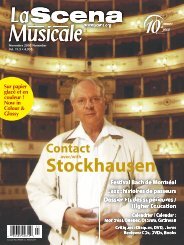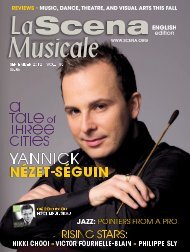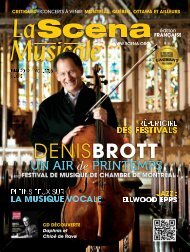The Bohlen-Pierce system - La Scena Musicale
The Bohlen-Pierce system - La Scena Musicale
The Bohlen-Pierce system - La Scena Musicale
You also want an ePaper? Increase the reach of your titles
YUMPU automatically turns print PDFs into web optimized ePapers that Google loves.
MICROTONALITY<br />
Sounds Unlikely<br />
THE BOHLEN-PIERCE SYSTEM<br />
by MARC CHÉNARD<br />
<strong>The</strong> story of microtonality might be<br />
as old as music itself. In non-Western<br />
music traditions, e.g. Indian<br />
Carnatic music or Arabic melismas,<br />
its use is commonplace. Western<br />
concert music, in contrast, is built on fixed<br />
pitches no closer together than the semitone<br />
and now commonly played with twelve-tone<br />
equal temperament, a device that effectively<br />
‘rounded off’ minute tone differences. While<br />
still confined to its margins, microtonality is<br />
gaining new acceptance in our culture, as witnessed<br />
by a steadily growing body of works exploring<br />
these timbral possibilites. <strong>The</strong> Russian<br />
Ivan Wyschnegradsky was a true pioneer in<br />
this respect, writing piano works for one or<br />
two pianos tuned in quartertones. Nowadays,<br />
there are festivals devoted to it, and works requiring<br />
tunings in eighth and sixteenth tones!<br />
A CHANCE DISCOVERY Even within<br />
the history of microtonality, the <strong>Bohlen</strong>-<strong>Pierce</strong><br />
<strong>system</strong> is a rather new entry, and one with a<br />
pretty offbeat history at that. For starters, it<br />
was devised not by a musician but by an<br />
engineer, one Heinz <strong>Bohlen</strong>. In the early 1970s,<br />
this specialist in communications and<br />
microwave electronics in Germany happened<br />
to offer his services to record concerts performed<br />
by the students of Hamburg’s<br />
Musikhochschule and their professors. <strong>Bohlen</strong><br />
was intrigued by the fact that all the music was<br />
created from an octave comprised of 12 steps.<br />
When he asked them about this, musicians<br />
(Hz)<br />
220 Hz<br />
seemed at a loss for an answer, as they were<br />
more interested in using these materials at<br />
their disposal than actually<br />
questioning their properties.<br />
Combing through the literature,<br />
he would find an answer in<br />
the relationships of tones forming<br />
a triad (known in the trade as 4:5:6,<br />
or unison:third:fifth). By tinkering with<br />
the pitch levels and generating a 3:5:7 combination<br />
instead, he stumbled upon a new<br />
scale of 13 steps spanning a 12 th rather than<br />
the usual octave. What this means is that<br />
every step of the new scale is equivalent to<br />
¾ of a tone in our traditional scale, a.k.a.<br />
‘diatonic.’ Mathematically then, it takes<br />
three semitones (3x1/2) to create a minor<br />
third (C,D,Eb), whereas it takes only two<br />
¾ tones of the <strong>Bohlen</strong>-<strong>Pierce</strong> <strong>system</strong> to<br />
achieve that interval, at least something<br />
very close to it. To prove his discovery,<br />
<strong>Bohlen</strong> decided to construct an instrument,<br />
his choice being an electronic organ.<br />
After a year’s work, and with help from<br />
fellow engineers, he had achieved his<br />
goal. In 1974, he convinced a professional<br />
organist to ‘road test’ it, and the<br />
musician managed to find a number<br />
of attractive sounding chords on it in<br />
spite of its rather primitive sound. This<br />
discovery, however, found limited<br />
acceptance in the music community,<br />
and was restricted to Germanic speakingcountries,<br />
thus going unnoticed in the<br />
community at large.<br />
250 300 350 400 450 500 550 600 650 700<br />
BOHLEN-PIERCE<br />
WESTERN<br />
1<br />
1<br />
2<br />
2<br />
3<br />
4<br />
3<br />
5<br />
4<br />
6<br />
7<br />
5<br />
8<br />
6<br />
9<br />
10<br />
7<br />
11<br />
8<br />
12<br />
440 Hz<br />
9<br />
10<br />
11<br />
12<br />
13<br />
660 Hz<br />
TWISTS OF FATE But the story does not<br />
end there. Kees van Prooijen in neighbouring<br />
Holland was an engineer by trade like <strong>Bohlen</strong>,<br />
yet had a background in music theory. In<br />
1978, independently of the German, he proposed<br />
an equal tempered version of the same<br />
scale, this one enabling consonance within<br />
higher harmonics. Oddly enough, he would<br />
not publish his findings until the mid-1990s<br />
through an odd twist of fate.<br />
Enter then John Robinson <strong>Pierce</strong>, the<br />
second ‘official’ discoverer of this <strong>system</strong>.<br />
Coincidentally, this Californian was also an<br />
engineer; in fact he’s remembered as the<br />
father of the communications satellite and<br />
godfather of the transistor. Yet he was also<br />
well versed in music theory and acoustic<br />
science. Not too long after making the<br />
same discovery, in 1984, and publishing<br />
his own research, he was made aware of<br />
<strong>Bohlen</strong>’s work, which led to the<br />
compounding of the names as the designation<br />
for the scale. And by another<br />
stroke of fate, all three parties involved in<br />
the find wound up living within miles of<br />
each other in the Bay Area in the mid<br />
1990s. Yet <strong>Bohlen</strong> and van Prooijen<br />
crossed paths on only one single occasion<br />
in 1996, while <strong>Pierce</strong> repeatedly refused invitations<br />
to meet the other two.<br />
<strong>The</strong> <strong>Bohlen</strong>-<strong>Pierce</strong> <strong>system</strong> has slowly<br />
found its way into the realm of musical creation.<br />
In fact the first musical program of<br />
works composed in that <strong>system</strong> occurred<br />
here in Canada in 2008, at the University<br />
of Guelph, one of them penned by a Montreal-based<br />
composer and percussionist,<br />
Todd Harrop. As for instruments, there is<br />
now a luthier in Boston who makes guitars<br />
tuned in that <strong>system</strong> as well as a maker<br />
of clarinets, Stephen Fox in Toronto, who<br />
has built a dozen of them, including a<br />
unique tenor model for a German musician,<br />
Nora-Louise Müller.<br />
• Read more on the http://blog.scena.org<br />
about Stephen Fox’s clarinets.<br />
• Read more on the history of<br />
the B.P. <strong>system</strong> at:<br />
www.huygens-fokker.org/bpsite<br />
LSM<br />
COMPARISON OF PITCH FREQUENCIES<br />
betwen the <strong>Bohlen</strong>-<strong>Pierce</strong> scale and<br />
the Western tempered scale<br />
IMAGE Adam Norris<br />
STEPHEN FOX’S BOHLEN-PIERCE<br />
tenor clarinet prototype<br />
PHOTO www.sfoxclarinets.com<br />
10<br />
APRIL 2012

















